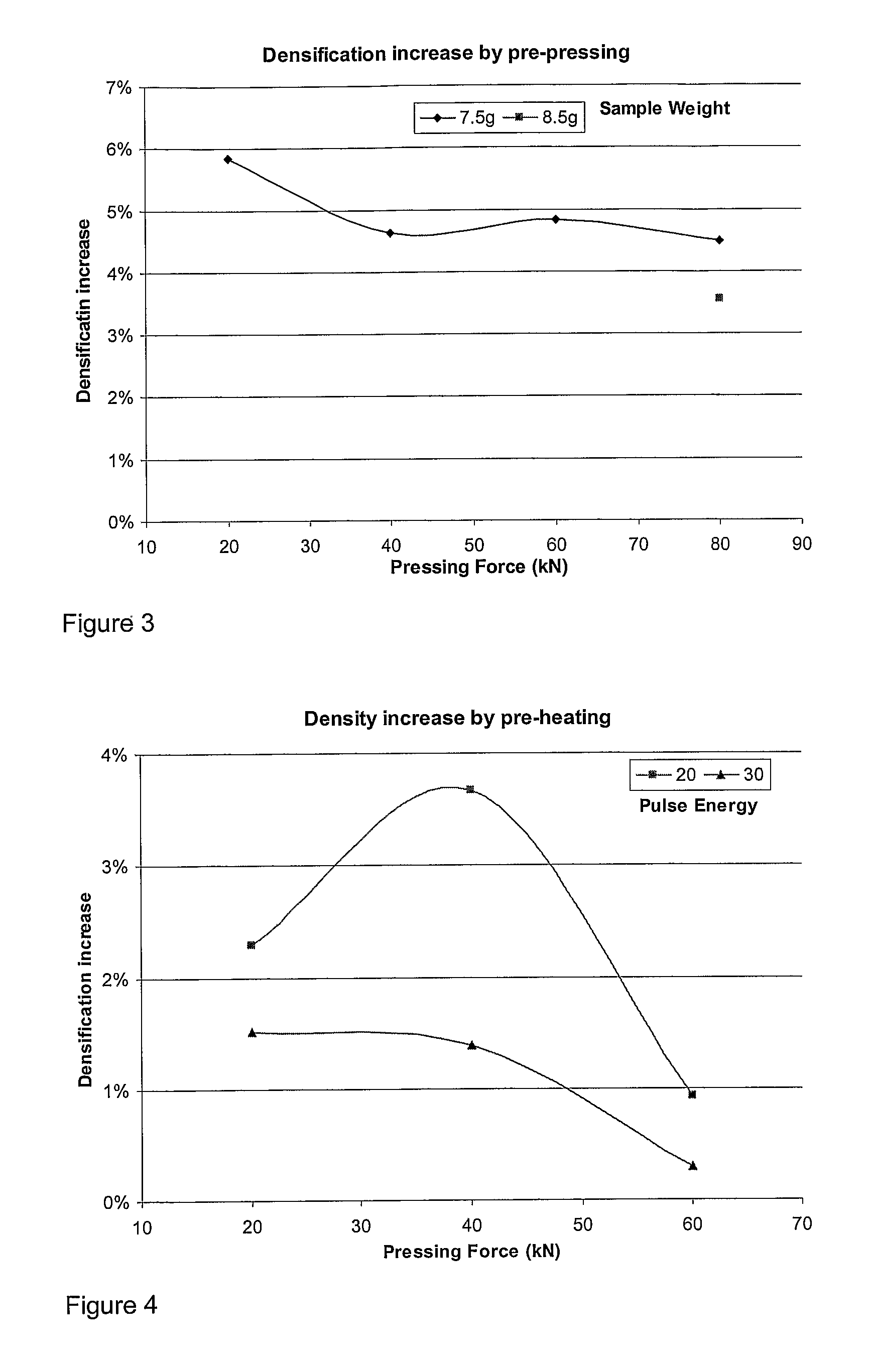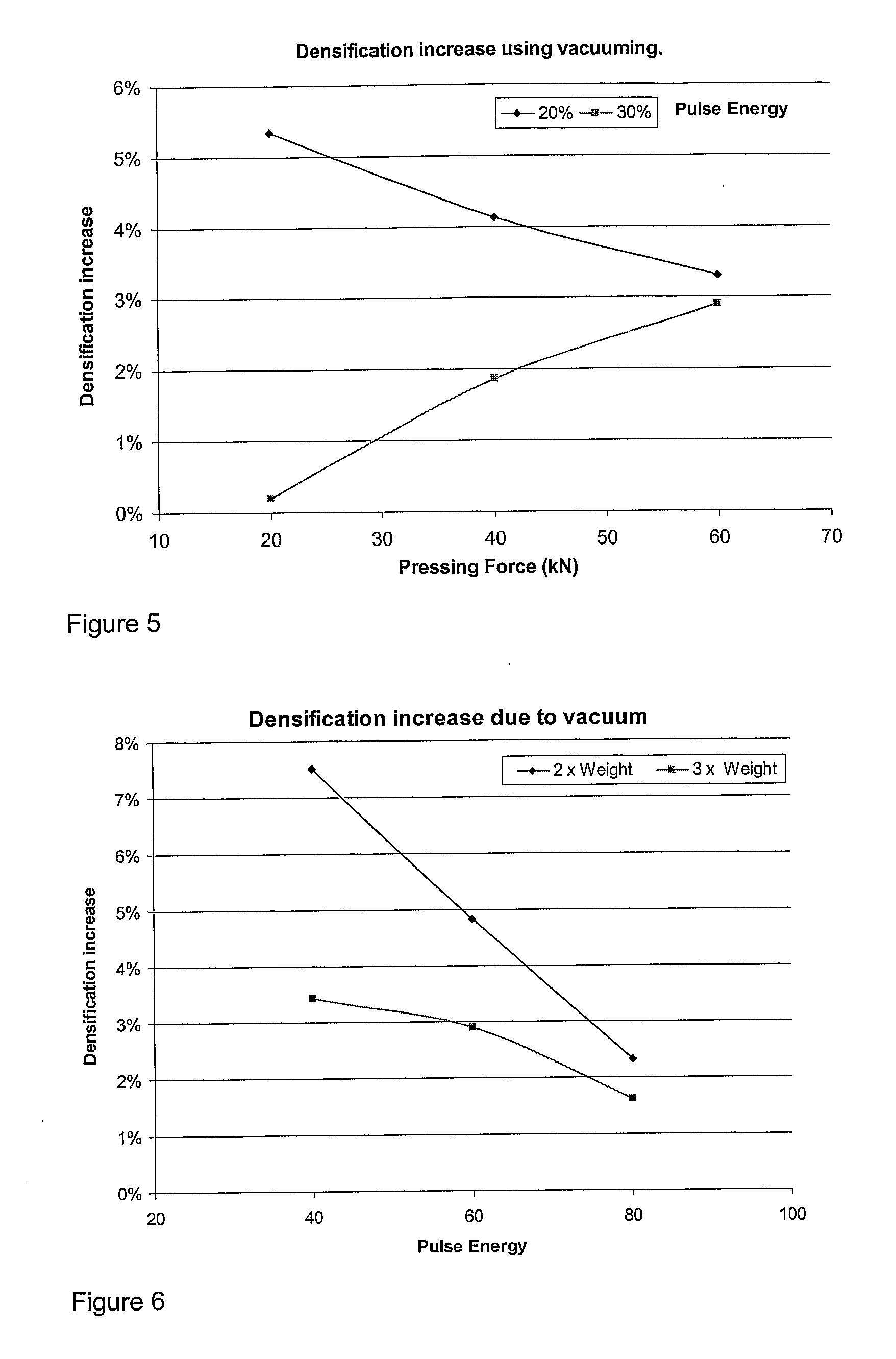High Density Abrasive Compacts
a high-density, compact technology, applied in the direction of grinding devices, electric/magnetic/electromagnetic heating, other chemical processes, etc., can solve the problems of poor wear resistance, poor diamond retention, and inability to oxidize powder materials, so as to prevent oxidation effect of powder materials
- Summary
- Abstract
- Description
- Claims
- Application Information
AI Technical Summary
Benefits of technology
Problems solved by technology
Method used
Image
Examples
example 1
[0054]Discs having a diameter of about 16 mm and a thickness of about 5 mm containing WC and Co with 25 / 30 mesh (#) sized diamond particles were cold pressed at 6 tonne per cm2 in a steel die. The WC and Co were encapsulated to surround each individual diamond particle and partially fired to remove the binder and give strength to the granules. These were separately sintered in an apparatus as generally described above using two current pulses at 100% power.
[0055]Two sets of samples were made, the second set of samples having an increased diamond concentration over the first.
[0056]A Paarl Granite cylindrical bar of diameter about 150 mm was mounted in a lathe. Each of the discs in turn was used to turn the granite using the following parameters:—[0057]Speed: 50 r / min[0058]Depth of Cut: 2 mm[0059]Feed rate: 0.1 mm / revolution
[0060]Each disc was allowed to cut for 4 minutes. In addition to the discs of the invention, a similar sized disc of standard tungsten carbide mining grade was sou...
example 2
[0065]30 / 35# diamond encapsulated with 26% cobalt and 20-50 micron tungsten carbide was used. To produce thin discs of this material, 5.12 g was used in a 13.81 mm diameter die. As a base line, to investigate the effect of pressing force and pulse energy, a matrix of tests were performed at varying pressing forces (20, 40 & 60 kN) and pulse energies (10, 20 and 30%). This matrix was repeated but using pre-pressed compacts. The densification increase which resulted by using pre-pressing is shown in FIG. 1. The effect is greatest at lower pressing force.
[0066]Further tests were done using twice (10.24 g) and three times (15.36 g) the material weight while holding the pressing force at 40 kN. Pulse energies of 20, 40, 60, 70 & 80% were used. As before, these tests were repeated using pre-pressed compacts. In this case, the densification increase which resulted is shown in FIG. 2. At higher pulse energies, the effect is about the same.
[0067]Using a 9.5 mm diameter mould, the maximum amo...
example 3
[0068]A repeat of the 5.12 g samples pre-pressed was performed but this time preheating the compacts to 200 deg C. before placing in the sintering chamber. Pre-heated samples were sintered at 20 & 30% pulse energy with pressing forces of 20, 40 & 60 kN being used. The densification of these was compared to the pre-pressed samples sintered without heating. The densification increase as a result of pre-heating is shown in FIG. 4.
PUM
| Property | Measurement | Unit |
|---|---|---|
| Fraction | aaaaa | aaaaa |
| Length | aaaaa | aaaaa |
| Length | aaaaa | aaaaa |
Abstract
Description
Claims
Application Information
 Login to view more
Login to view more - R&D Engineer
- R&D Manager
- IP Professional
- Industry Leading Data Capabilities
- Powerful AI technology
- Patent DNA Extraction
Browse by: Latest US Patents, China's latest patents, Technical Efficacy Thesaurus, Application Domain, Technology Topic.
© 2024 PatSnap. All rights reserved.Legal|Privacy policy|Modern Slavery Act Transparency Statement|Sitemap



